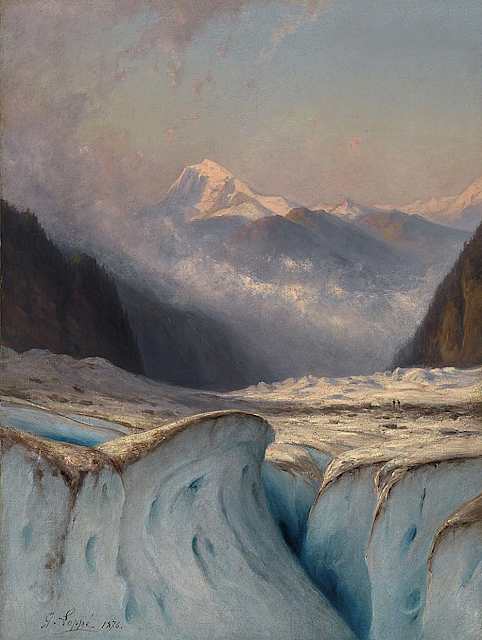CHARLES-HENRI CONTENCIN (1898-1955)
Le Cervin / Matterhorn/ Cervino (4,478m -14,691ft)
Suisse / Italie
La montagne
Le Cervin (4,478m -14,691ft)
appelé aussi Matterhorn et Cervino) est le 12e sommet des Alpes en
atltude. Il est situé sur la frontière italo-suisse, entre le canton du
Valais et la Vallée d'Aoste. Il donne sur la ville suisse de Zermatt au
nord-est et la ville italienne de Breuil-Cervinia au sud. Il relie la
vallée de Zermatt et le Valtournenche, dans le Val d’Aoste, par le col
de Saint-Théodule, à l’est. Le Cervin est la montagne la plus connue de
Suisse, notamment pour l'aspect pyramidal qu'elle offre depuis la ville
de Zermatt, dans la partie alémanique du canton du Valais. Son image est
régulièrement utilisée pour les logos de marques commerciales.
L'ascension par l'arête du Hörnli, le 14 juillet 1865, est considérée
comme le dernier des grands exploits de l'alpinisme dans les Alpes. Mais
cette ascension réalisée sous la conduite d'Edward Whymper se solde, au
début de la descente, par la mort de quatre des sept membres de la
cordée victorieuse. Sa face nord est l'une des trois grandes faces nord
des Alpes avec celles de l'Eiger et des Grandes Jorasses.
Charles-Henri Contencin, est un peintre de montagne français. Élevé par sa grand-mère dans l'Oberland bernois jusqu'à l'âge de 10-12 ans, il demeure toute sa vie un passionné de montagne. Il fait la grande guerre dans l'infanterie et il reçoit la Croix de Guerre. Il travaille ensuite dans un cabinet d'architecte puis à la Compagnie des chemins de fer du Nord et enfin à la SNCF où il sera responsable des ouvrages d'art. Doué pour le dessin, industriel et artistique, il a suivi des cours de dessin à l'école ABC de dessin de Paris3. En plus de ses dessins professionnels il est également auteur d'affiches et de prospectus publicitaires pour les chemins de fer sous le pseudonyme de « Charles-Henri ». Il est surtout connu pour sa peinture de montagne et laisse, en la matière, une œuvre importante. Il est entré à la SPM en 1929, en a été secrétaire général de 1950 à 1953, puis président de 1954 à 1955. Il a exposé régulièrement au Salon des artistes français. Il a également exposé au Salon des indépendants, de 1927 à 1938, notamment des tableaux représentant des paysages de Haute-Savoie et du Midi, au Salon de l'école française en 1932 : Neige à Chamonix et Argentière (vallée de Chamonix) et au Salon d'hiver de 1945 à 1950. Sa palette est caractéristique et il apprécie tout particulièrement les effets de lever ou de coucher de soleil sur la neige ou les glaciers.
______________________________________
2023 - Gravir les montagnes en peinture
Un blog de Francis Rousseau

%20Le%20Mont%20Blanc%20vu%20de%20La%20Route%20de%20Saint-Gervais%20a%CC%80%20Mege%CC%80ve,%20France%20oil%20on%20canvas%2018%20x%2021%C2%BEin%20(46%20x%2055cm)%20-John%20Mitchell%20gallery%20.png)














-%20The%20mattherhorn%20from%20%20Riffelsee-%20John%20Mitchell%20gallery%20London%20.png)
